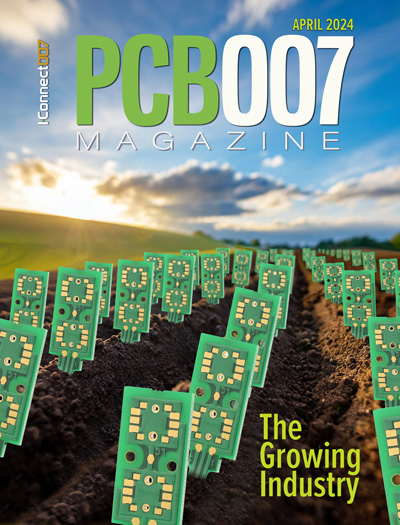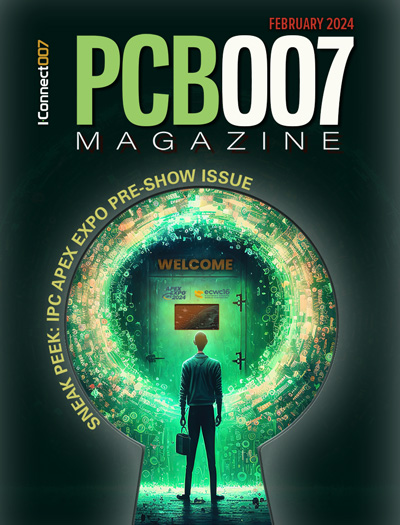-

- News
- Books
Featured Books
- pcb007 Magazine
Latest Issues
Current Issue
The Growing Industry
In this issue of PCB007 Magazine, we talk with leading economic experts, advocacy specialists in Washington, D.C., and PCB company leadership to get a well-rounded picture of what’s happening in the industry today. Don’t miss it.

The Sustainability Issue
Sustainability is one of the most widely used terms in business today, especially for electronics and manufacturing but what does it mean to you? We explore the environmental, business, and economic impacts.

The Fabricator’s Guide to IPC APEX EXPO
This issue previews many of the important events taking place at this year's show and highlights some changes and opportunities. So, buckle up. We are counting down to IPC APEX EXPO 2024.
- Articles
- Columns
Search Console
- Links
- Events
||| MENU - pcb007 Magazine
Alun Morgan on Thermal Management and LEDs in Automotive
April 25, 2019 | Judy WarnerEstimated reading time: 18 minutes
Guest Editor Judy Warner met with Alun Morgan, technology ambassador for Ventec International Group, to discuss topics addressed at the Automotive Executive Forum that took place at IPC APEX EXPO 2019. Morgan describes his presentation and findings centered around thermal management in automotive, specifically LEDs, as well as the unique set of growing thermal management challenges Tier 1 (T1) suppliers are now facing in the automotive sector.
Judy Warner: Welcome, Alun. I wanted to talk to you a little bit about the presentation you did at the Automotive Executive Forum. Could you tell us a little bit about what you presented on and what came out of that?
Alun Morgan: It was a very interesting forum. We had speakers from across the whole automotive sector, including OEMs, Tier 1 suppliers, and test houses. The idea was to look at the implications of electronics in automotive. The particular topic I focused on was thermal management. We heard about how we integrate electrical properties with mechanical properties, which is a big topic for automotive. Rather than just thinking about the circuit just as an interconnect, there’s a mechanical component as well. I tried to explain that having the electrical properties is a given, but on top of that, there’s also thermal management that we can build into the substrate.
Specifically, I discussed LED lighting, which has become very popular in vehicles. It started as cabin illumination or sometimes daylight running lights or indicators, but now it’s mainstream in headlamps. These are pretty high-powered devices. And even though LEDs are pretty efficient, at the most, they only run approximately 40% of the output power that is turned to light—the other 60% is heat. In some cases, 85% is heat, and you have to manage that.
So, you have this very intense device at the front of a headlamp cluster, generating a lot of heat, and it’s turned on in an instant, of course, so the heat comes straight away; that must be managed. If you don’t, there are issues of reliability, the device can fail, and these are designed for the life of the vehicle. You don’t want to have to change these at any point in the life of the vehicle. If the temperature changes, you also change the color of the light, which is also unacceptable for the automotive sector.
Thus, the whole concept is that we build a substrate that is fairly thin to build the circuitry on. The back of that has an aluminium layer, and then the back of that has a radiative layer applied. The heat generated by the device can be spread and dissipated, and then it can be dispersed into the environment behind the cluster. We call this an insulated metal substrate (IMS) material, and it has become a go-to device for automotive headlamps. Without that, you’re talking about a lot of mechanical structures and old, ribbed heat sinks and massive devices with forced air cooling that we used to see.
However, the problem with that is there’s no space. Secondly, they’re very expensive. IMS materials are a great solution to bring into the automotive sector, so that has been the trend for a while. Ventec has a number of products that fit into that space, which was the basis of the discussion. There was some talk around how heat flows, from where, and how we have to manage that, which is an interesting background story for people.
It all sounds very easy and straightforward, but there can be issues as well. Sometimes a design is made, and we do the calculations, so we know from the OEM what space they have, the size they have for the circuitry, the temperature they want to run at, and the dissipation in the heat of the device. We can calculate from that what’s required to make that heat dissipate. This process works very well. There are usually two components: a convective and a radiative component.
Traditionally, the convective component is the biggest one so that we remove most heat by convection. The cold air in the radiator heats up, rises, and more cold air is replaced. You have a constant stream of new, cold air running around. However, the radiation side is also very important. And because we now have a patented process for treatment on the back layer of the aluminium, we can radiate a lot more energy than we could in the past. Now, 50% of the heat we can radiate or eliminate is by radiation. We’ve managed to improve the radiation properties significantly of that radiator. That’s the way we built it from the design brief; generally, it works, but it occasionally goes wrong.
Warner: Like all things in electronics tend to do.
Morgan: Right. So the OEMs or T1 suppliers have test regimes. These are quite onerous, so we’re talking -40°C to +105°C or 150°C, for example, and pretty quick cycles; talk about going from low to high temperatures in the space of a few seconds. Imagine a vehicle in Finland. You go out in the morning and turn on the engine. The headlamps immediately power up, giving 12–20 watts of power in the space of one-millimeter square, and you’ve gone from -30°C to +80°C in a matter of seconds, and you do that over and over. You drive around, park the car, it cools down, and you do it again and again.
Typically, cycles of testing run up to 3,000 times on that range. We found that with a traditional solution, two OEMs came in with issues. One was a failure in the interconnect between the device, which was in a ceramic package and the solder joints, that were failing completely. We looked at it and wondered what could be the cause. At the same time, another issue came in with again another traditional solution where the circuit traces were cracking and fracturing underneath the solder joints. We call these no-light failures, and when it comes to a headlamp, that’s about as bad as it gets.
Page 1 of 4
Suggested Items
AIM Solder Signs Shinil Fl Ltd. as New Distributor for Korea
05/08/2024 | AIM SolderAIM Solder, a leading global manufacturer of solder assembly materials for the electronics industry, is pleased to announce a new distribution partnership with Shinil Fl Ltd., a prominent supplier of technological solutions in the SMT and semiconductor sectors.
Indium Corporation to Showcase HIA Materials at ECTC
05/07/2024 | Indium CorporationAs an industry leader in innovative materials solutions for semiconductor packaging and assembly, Indium Corporation® will feature its advanced products designed to meet the evolving challenges of heterogeneous integration and assembly (HIA) and fine-pitch system-in-package (SiP) applications at the 74th Electronic Components and Technology Conference (ECTC), May 28‒31, in Denver, Colorado.
Indium Corporation Expert to Present on Pb-Free Solder for Die-Attach in Discrete Power Applications
04/30/2024 | Indium CorporationIndium Corporation Product Manager – Semiconductor Dean Payne will present at the Advanced Packaging for Power Electronics conference, hosted by IMAPS, held May 8-9 in Woburn, Massachusetts, USA.
Taiyo Circuit Automation Installs New DP3500 into Fuba Printed Circuits, Tunisia
04/25/2024 | Taiyo Circuit AutomationTaiyo Circuit Automation is proud to be partnered with Fuba Printed Circuits, Tunisia part of the OneTech Group of companies, a leading printed circuit board manufacturer based out of Bizerte, Tunisia, on their first installation of Taiyo Circuit Automation DP3500 coater.
Vicor Power Orders Hentec Industries/RPS Automation Pulsar Solderability Testing System
04/24/2024 | Hentec Industries/RPS AutomationHentec Industries/RPS Automation, a leading manufacturer of selective soldering, lead tinning and solderability test equipment, is pleased to announce that Vicor Power has finalized the purchase of a Pulsar solderability testing system.


